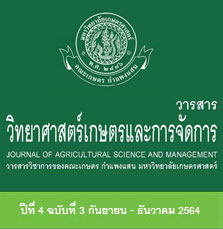การวิเคราะห์ปริมาณคลอโรฟิลล์และแคโรทีนอยด์ที่สกัดด้วยตัวทำละลายหลายชนิดด้วยเทคนิคสเปกโตรโฟโตมิเตอร์ในใบของบุกเนื้อทราย
คำสำคัญ:
บุกเนื้อทราย, รงควัตถุ, ค่าความเขียวของใบ, คลอโรฟิลล์มิเตอร์บทคัดย่อ
การศึกษานี้มีวัตถุประสงค์เพื่อเปรียบเทียบปริมาณคลอโรฟิลล์และแคโรทีนอยด์ที่สกัดจากเนื้อเยื่อใบบุกเนื้อทรายด้วยสารสกัดชนิดต่าง ๆ และเพื่อศึกษาความสัมพันธ์ระหว่างปริมาณคลอโรฟิลล์ที่ประเมินได้และค่าความเขียวของใบที่วัดด้วยเครื่องคลอโรฟิลล์มิเตอร์ ในการศึกษานี้ทำการสกัดคลอโรฟิลล์และแคโรทีนอยด์จากใบที่เจริญเต็มที่แล้วของบุกเนื้อทรายด้วยสารละลายไดเมทิลซัลฟอไซด์ (DMSO) เอทานอล 95% อะซีโตน 80% และอะซีโตน 90% โดยวางแผนการทดลองแบบ CRD ทำ 30 ซ้ำ (ต้น) พบว่า ตัวทำละลายที่ให้ปริมาณคลอโรฟิลล์เอ คลอโรฟิลล์บี และคลอโรฟิลล์รวมสูงสุดคือ DMSO และเอทานอล 95% ส่วนปริมาณแคโรทีนอยด์สูงสุดเมื่อสกัดด้วยอะซีโตน 80% และอะซีโตน 90% ความสัมพันธ์ระหว่างค่าความเขียวใบที่วัดด้วยคลอโรฟิลล์มิเตอร์มีความสัมพันธ์เชิงบวกกับปริมาณคลอโรฟิลล์ โดยมีสมการถดถอยเชิงเส้นตรงเป็น y=0.0682x-1.0577 (R2 = 0.70), y=0.0459x-0.6321 (R2 = 0.67) และ y=0.0221x-0.4285 (R2=0.73) สำหรับประเมินปริมาณคลอโรฟิลล์รวม คลอโรฟิลล์เอ และคลอโรฟิลล์บี ตามลำดับ ดังนั้นการใช้ค่าความเขียวใบจึงสามารถใช้ประเมินปริมาณคลอโรฟิลล์ในใบบุกเนื้อทรายแบบไม่ทำลายตัวอย่างเพื่อบ่งชี้ความสมบูรณ์ของต้นพืชได้
เอกสารอ้างอิง
พรเทพ ธีระวัฒนพงศ์ และระวี เจียรวิภา. 2560. การประเมินคลอโรฟิลล์และแคโรทีนอยด์ในพืชอาหารสัตว์โดยใช้ SPAD-502Plus และ GreenseekerTM, หน้า 104-110. ใน: การประชุมทางวิชาการของมหาวิทยาลัยเกษตรศาสตร์ครั้งที่ 55 สาขาพืช, มหาวิทยาลัยเกษตรศาสตร์, กรุงเทพฯ.
สิริมาส วงศ์สุบรรณ, กฤษณา กฤษณพุกต์ และลพ ภวภูตานนท์. 2555. การใช้คลอโรฟิลล์มิเตอร์ประเมินระดับคลอโรฟิลล์และไนโตรเจนในใบส้มโอ. วารสารวิทยาศาสตร์และเทคโนโลยี 1(3):40-50.
Akhter. M. M., A. Houssain., J. Timsina., J. A. T. Silva and M.S. Islam. 2016. Chlorophyll meter – a decision-making tool for nitrogen application in wheat under light soils. International Journal of Plant Production 10(3):289-302.
Arnon. D.I. 1949. Copper enzymes in isolated chloroplasts. Polyphenol oxidase in Beta vulgaris. Plant Physiology 24: 1-15.
Balouchi. H.R. 2010. Screening wheat parents of mapping population for heat and drought tolerance detection of wheat genetic variation. International Scholarly and Scientific Research and Innovation 4(6): 61- 71.
Barnes, J.D., L. Blaguer, E. Manrique, S. Elvira and A.W. Davison. 1992. A reappraisal of the use of DMSO for the extraction and determination of chlorophyll a and b in lichens and higher plants. Environmental and Experimental Botany 32: 85-100.
Cuin. T. A., D. Parsons and S. Shabala. 2010. Wheat cultivars can be screened for NaCl salinity tolerance by measuring leaf chlorophyll content and shoot sap potassium. Functional Plant Biology 37(7): 656-664. doi: org/10.1071/FP09229.
Dekov. I., T. Tsonev. and I. Yordanov. 2000. Effects of water stress and high-temperature stress on the structure and activity of photosynthetic apparatus of Zea mays and Helianthus annuus. Photosynthetica 38(3): 361-366, 2000. doi: 10.1023/a:1010961218145.
DellaPenna, D. 1999. Carotenoid synthesis and function in plants: insights from mutant studies in Arabidopsis thaliana, pp.21-37. In: Frank, H.A., A.J. Young, G. Britton and R.J. Cogdell (eds.). The Photochemistry of Carotenoids. Kluwer Academic Publishers. Netherlands.
Fernandes, F.M., R.P. Soratto, A.M. Fernandes and E.F.C. Souza. 2021. Chlorophyll meter-based leaf nitrogen status to manage nitrogen in tropical potato production. Agronomy Journal 113(2): 1733-1746.
Francisco. J. C. G., R. A. Marenco. and G. Vieira. 2001. Concentration of photosymthetic pigments and chlorophyll fluorescence of mahogany and tonka bean under two light evaroments. Institute for Research in the Amazon., C.P.478, 69011-970.
Giunta. F., R. Motzo and M. Deidda. 2002. SPAD readings and associated leaf traits in durum wheat, barley and triticale cultivars. Euphytica 125: 197–205.
Hendry. G.A.F. and A.H. Price. 1993. Stress indicators: chlorophylls and carotenoids. pp. 148–152. In G.A.F. Hendry and J.P. Grime (eds). Methods in Comparative Plant Ecology. Chapman & Hall, London.
Hiscox, J.D. and G.F. Israelstam. 1979. A method for the extraction of chlorophyll from leaf tissue without maceration. Canadian Journal of Botany 57: 1332-1334.
Jiang, c., M. Johkan., M. Hohjo., S. Tsukagoshi and T. Maruo. 2017. A correlation analysis on chlorophyll content and SPAD value in tomato leaves. HortResearch 71: 37-42.
Kumari, R. S. Ashraf, G.K. Bagri, S.K. Khatik, D.K. Bagri and D.L. Bagdi. 2018. Extraction and estimation of chlorophyll content of seed treated lentil crop using DMSO and acetone. Journal of Pharmacognosy and Phytochemistry 7: 249-250.
Lichtenthaler. H.K. 1987. Chlorophylls and carotenoids: Pigments of photosynthetic biomembranes. Methods in Enzymology. 148, 350-382.
Makeen, K., G. Suresh Babu, G.R. Lavanya and G. Abraham. 2007. Studies of chlorophyll content by different methods in black gram (Vigna mungo L.). International Journal of Agricultural Research 2: 651-654.
Markwell, J., J.C. Osterman and J.L. Mitchell. 1995. Calibration of the Minolta SPAD-502 leaf chlorophyll meter. Photosynthesis Research 46:467-472.
Minocha, R. G. Martinez, B. Lyons and S. Long. 2009. Development of a standardized methodology for quantifying total chlorophyll and carotenoids from foliage of hardwood and conifer tree species. Canadian Journal of Forest Research 39: 849-861.
Munns. R. and R. A .Jame. 2003. Screening methods for salinity tolerance: a case study with tetraploid wheat. Plant and Soil 253: 201–18.
Porra, R.J. 2002. The chequered history of the development and use of simultaneous equations for the accurate determination of chlorophylls a and b. Photosynthesis Research 73: 149-156.
Santosa. E., I. Setiasih, Y. Mine and N. Sugiyama. 2011. Nitrogen and potassium applications on the growth of Amorphophallus muelleri Blume. Journal of Agronomy of Indonesia 39(2):124-130.
Shah, S.H., R. Houborg and M.F. McCabe. 2017. Response of chlorophyll, carotenoid and SPAD-502 measurement to salinity and nutrient stress in wheat (Triticum aestivum L.). Agronomy 61.
doi: 10.3390/agronomy7030061.
Sim, C. C., A.R. Zaharah, M.S. Tan and K.J. Goh. 2015. Rapid determination of leaf chlorophyll concentration, photosynthesis activity and NK concentration of Elaies guineensis via correlated SPAD-502 chlorophyll index. Asian Journal of Agricultural Research 9: 132-138.
Tait, M.A. and D.S. Hik. 2003. Is dimethylsulfoxide a reliable solvent for extracting chlorophyll under field conditions. Photosynthesis Research 78: 87-91.
Uddling, J., J. Gelang-Affredsson and K. Piikki. 2007. Evaluating the relationship between leaf chlorophyll concentration and SPAD-502 chlorophyll meter readings. Photosynthesis Research 91: 37-46.
Wellburn. A. R. 1994. The spectral determination of chlorophylls a and b, as well as total carotenoids, using various solvents with spectrophotometers of different resolution. Journal of Plant Physiology 144(3): 307-313. doi: org/10.1016/S0176-1617(11)81192-2.
Yang. H., J. Yang., Y Lv and J. He. 2014. Spad values and nitrogen nutrition index for the evaluation of rice nitrogen. Plant Production Science 17(1): 81-92. doi:10.1626/pps.17.81.
Zulkarnaini, Z.M., S.Z. Sakimin, M.T.M. Mohamed and H.Z.E. Jaafar. 2019. Relationship between chlorophyll content and soil plant analytical development values in two cultivars of fig (Ficus carica L.) as brassinolide effect at an open field. IOP Conference Series: Earth and Environmental Science Science 250, doi: 10.1088/1755-1315/250/1/012025.






